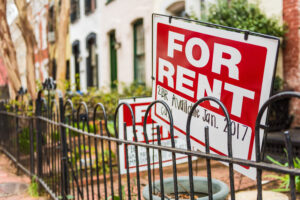Rental housing laws surrounding your application, tenant screening, and the decision process are constantly evolving, and it can be tough to keep up. While the leasing process has grown to become time-consuming and complex, it’s vital that you not only establish written rental criteria but update it annually to adapt to the changing rental housing climate. We’ve rounded up the top 5 key factors to creating the best rental standards.
Rental housing laws surrounding your application, tenant screening, and the decision process are constantly evolving, and it can be tough to keep up. While the leasing process has grown to become time-consuming and complex, it’s vital that you not only establish written rental criteria but update it annually to adapt to the changing rental housing climate. We’ve rounded up the top 5 key factors to creating the best rental standards.
Written Rental Criteria 101
If you’re unfamiliar with what a rental criteria is, here’s your crash course (if you’re already familiar, you can skip ahead). Rental criteria are standards rental applicants must meet in order to be considered “approved,” “conditionally approved,” or “denied” for a unit.
Most leasing criteria includes the following:
- Credit score ranges
- Income requirements
- Some payment or tradeline criteria
- Specific criteria regarding criminal convictions
- Specific criteria regarding eviction records


Written Rental Criteria 101
If you’re unfamiliar with what a rental criteria is, here’s your crash course (if you’re already familiar, you can skip ahead). Rental criteria are standards rental applicants must meet in order to be considered “approved,” “conditionally approved,” or “denied” for a unit.
Most leasing criteria includes the following:
- Credit score ranges
- Income requirements
- Some payment or tradeline criteria
- Specific criteria regarding criminal convictions
- Specific criteria regarding eviction records
While you can add most anything you want to your leasing criteria, including standards involving landlord or personal references, you’ll need to be cautious. Verifications from prior addresses and personal references should be taken with a grain of salt, as they don’t always come from a reliable source. They also aren’t the most objective and could be difficult to explain to an applicant if denied the unit.
- Quick Tip! If you do incorporate verbal verifications into your leasing decision, write a script! You’ll want to make sure you use the same verification questions for all your rental applicants’ prior landlords.
5 Key Factors to Making the Best Rental Standards
Unfortunately, drafting up your leasing standards isn’t so simple. As you’re establishing the written rental criteria and later annually auditing it, you’ll need to keep these four factors in mind:
1. Your Decision Should ALWAYS be Based on Objective Data
While some rental owners might preach the power of looking up their applicants’ social media or any other strange and subjective measures, doing this will get you a one-way ticket to plenty of legal fees. You need to make sure your leasing process uses objective data. Stick to what’s industry standard – using credit, criminal, and eviction data from your tenant screening service. Tenant screening reports provide objective (and legal) information to help you figure out if an applicant could be a liability.
2. Avoid Blanket Standards
Blanket standards (also known as “Bright-Line Standards”) are overly broad language in your rental criteria. These standards do not factor in the differences in laws on the federal, state, and county level. Oftentimes, these standards can actually increase your liabilities, as many argue they lead to discrimination.

A common example of bright-line standards is the “no felonies” rule. The issue with this criterion is that it doesn’t account for what different states consider to be a felony. In one state, medical marijuana could be illegal, in another, it could be perfectly legal. “No felonies” also bars applicants who have non-violent, non-threatening felonies – like the possession of an eagle feather. By having this blanket standard, you bar potentially good applicants before even looking at what their criminal conviction really was. And that’s a problem.
3. Consider Local Laws
Once you have a rough draft of your rental criteria (approved, denied, and conditional), it’s time to look at your local laws. Believe it or not, local laws can greatly restrict how much information you can consider when reviewing a rental applicant’s eligibility, and they’ve become increasingly popular with local legislators. In Cook County, Illinois, rental properties can only consider criminal convictions that happened within the past 3 years. In Seattle, Washington, you can only consider the sex offender registry.
Why does this matter? Most tenant screening companies abide by the 7-year rule. It’s an industry standard that provides rental properties like yours all of an applicant’s criminal convictions from the past 7 years. The problem with this, is that as we said above, not all local governments let you consider 7 years’ worth of criminal records. Unless you’re getting your criminal data from ApplyConnect (we’re coming out with a Regulatory Matrix to filter data so you don’t see records you legally cannot consider soon), you’re 100% liable if you deny an applicant based on criminal records that you weren’t supposed to consider.
So bottom line, when you’re reviewing your rental criteria, check your local laws and make sure you detail if you can review 3 years, 5 years, 7 years, or more of criminal records.
4. Consider Protected Classes
If you’re using objective data from your resident screening report to base your decisions, then you shouldn’t have an issue with this, but it bears repeating. Make sure your policies aren’t infringing on any protected classes – both federally and state-wide. Federally, the Fair Housing Act (FHA) prohibits discrimination based on race, color, national origin, religion, sex, familial status, and disability. Your state might also have additional protected classes like source of income, sexual orientation, or gender identity and gender expression.
5. Tailor your Standards to the Property
You wouldn’t have the same leasing standards for a city-living luxury apartment as an out-in-the-country duplex, would you? Each rental property is unique and can attract vastly different rental applicants. If you own or manage multiple properties, you’re going to want to tailor your standards to each property.
This process will vary based on your portfolio. For some, this might mean creating separate written rental standards for each of their properties or tweaking an existing criteria’s credit score and income requirements for a handful of similar properties. For others, this might mean sorting each property into A (new, desirable properties), B (slightly older, “middle class” properties), and C (30 years or older properties in a lower-income area) categories and just creating standards for A, B, and C classes.

While you can add most anything you want to your leasing criteria, including standards involving landlord or personal references, you’ll need to be cautious. Verifications from prior addresses and personal references should be taken with a grain of salt, as they don’t always come from a reliable source. They also aren’t the most objective and could be difficult to explain to an applicant if denied the unit.
- Quick Tip! If you do incorporate verbal verifications into your leasing decision, write a script! You’ll want to make sure you use the same verification questions for all your rental applicants’ prior landlords.
5 Key Factors to Making the Best Rental Standards
Unfortunately, drafting up your leasing standards isn’t so simple. As you’re establishing the written rental criteria and later annually auditing it, you’ll need to keep these four factors in mind:
1. Your Decision Should ALWAYS be Based on Objective Data
While some rental owners might preach the power of looking up their applicants’ social media or any other strange and subjective measures, doing this will get you a one-way ticket to plenty of legal fees. You need to make sure your leasing process uses objective data. Stick to what’s industry standard – using credit, criminal, and eviction data from your tenant screening service. Tenant screening reports provide objective (and legal) information to help you figure out if an applicant could be a liability.

2. Avoid Blanket Standards
Blanket standards (also known as “Bright-Line Standards”) are overly broad language in your rental criteria. These standards do not factor in the differences in laws on the federal, state, and county level. Oftentimes, these standards can actually increase your liabilities, as many argue they lead to discrimination.
A common example of bright-line standards is the “no felonies” rule. The issue with this criterion is that it doesn’t account for what different states consider to be a felony. In one state, medical marijuana could be illegal, in another, it could be perfectly legal. “No felonies” also bars applicants who have non-violent, non-threatening felonies – like the possession of an eagle feather. By having this blanket standard, you bar potentially good applicants before even looking at what their criminal conviction really was. And that’s a problem.
3. Consider Local Laws
Once you have a rough draft of your rental criteria (approved, denied, and conditional), it’s time to look at your local laws. Believe it or not, local laws can greatly restrict how much information you can consider when reviewing a rental applicant’s eligibility, and they’ve become increasingly popular with local legislators. In Cook County, Illinois, rental properties can only consider criminal convictions that happened within the past 3 years. In Seattle, Washington, you can only consider the sex offender registry.
Why does this matter? Most tenant screening companies abide by the 7-year rule. It’s an industry standard that provides rental properties like yours all of an applicant’s criminal convictions from the past 7 years. The problem with this, is that as we said above, not all local governments let you consider 7 years’ worth of criminal records. Unless you’re getting your criminal data from ApplyConnect (we’re coming out with a Regulatory Matrix to filter data so you don’t see records you legally cannot consider soon), you’re 100% liable if you deny an applicant based on criminal records that you weren’t supposed to consider.
So bottom line, when you’re reviewing your rental criteria, check your local laws and make sure you detail if you can review 3 years, 5 years, 7 years, or more of criminal records.
4. Consider Protected Classes
If you’re using objective data from your resident screening report to base your decisions, then you shouldn’t have an issue with this, but it bears repeating. Make sure your policies aren’t infringing on any protected classes – both federally and state-wide. Federally, the Fair Housing Act (FHA) prohibits discrimination based on race, color, national origin, religion, sex, familial status, and disability. Your state might also have additional protected classes like source of income, sexual orientation, or gender identity and gender expression.

5. Tailor your Standards to the Property
You wouldn’t have the same leasing standards for a city-living luxury apartment as an out-in-the-country duplex, would you? Each rental property is unique and can attract vastly different rental applicants. If you own or manage multiple properties, you’re going to want to tailor your standards to each property.
This process will vary based on your portfolio. For some, this might mean creating separate written rental standards for each of their properties or tweaking an existing criteria’s credit score and income requirements for a handful of similar properties. For others, this might mean sorting each property into A (new, desirable properties), B (slightly older, “middle class” properties), and C (30 years or older properties in a lower-income area) categories and just creating standards for A, B, and C classes.
Applying your Standards
So, you have your leasing standards… now what? In order to stay compliant with the FHA, you must be diligent in ensuring those standards are being applied equally. Every rental applicant that applies to your property should be vetted with the same qualifying questions and application, same background screening process, and with same rental criteria. Of course, each of your properties might have different criteria, but the future renters who apply must be treated equally regardless of which property they apply to.
At the end of the day, written rental standards help you discover which applicants will make trustworthy renters and pose a minimum risk. It also minimizes potential legal liabilities regarding discrimination. Just makes sure you audit each of your properties’ rental criteria annually to keep up with the times!
Subscribe!
Applying your Standards
So, you have your leasing standards… now what? In order to stay compliant with the FHA, you must be diligent in ensuring those standards are being applied equally. Every rental applicant that applies to your property should be vetted with the same qualifying questions and application, same background screening process, and with same rental criteria. Of course, each of your properties might have different criteria, but the future renters who apply must be treated equally regardless of which property they apply to.
At the end of the day, written rental standards help you discover which applicants will make trustworthy renters and pose a minimum risk. It also minimizes potential legal liabilities regarding discrimination. Just makes sure you audit each of your properties’ rental criteria annually to keep up with the times!
Subscribe!







